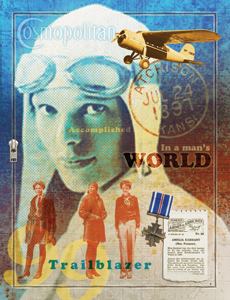“The most effective way to do it, is to do it.”
DID YOU KNOW…
- Amelia Earhart may have been the inspiration for the first long-haul trucker. She, however, would stay awake during her long flights by using smelling salts — not NoDoz.
- The future flier was less than impressed when she first saw a plane at age 10. Precocious even then, she described the Wright brothers-style machine as “a thing of rusty wire and wood and not at all interesting.”
- Earhart intended to land in Paris at the end of her first nonstop, transatlantic solo flight. She touched down just 700 miles off course — in a field in Ireland. She famously shocked a farmhand when he asked how far she had come. Her straight-faced response: “From America.”
Michelle Nicol might as well have used a crystal ball when choosing her topic for an elementary school project.
The figure of Amelia Earhart, clad in dashing pants and with more than a streak of independence, enchanted the future owner of Blue Marlin Pools of Brevard , a Pool & Spa News Top Builder in Melbourne, Fla.
Today, Nicol counts herself as one of a handful of female contractors in the pool and spa industry, and is the only female full-owner to make the Top Builder list.
“When I was growing up, women were under the men’s thumbs,” Nicol remembers. “Learning about [Amelia Earhart] showed me women can really succeed in an area that is male-dominated.” Spurred by the pilot’s many accomplishments, Nicol was spotlighted in her high school yearbook as “Most Likely to Become the First Female President.”
Earhart is best known for her mysterious disappearance over the Pacific Ocean in 1937 during an around-the-world flight attempt. But that’s far from the most unusual fact about the pioneering “aviatrix,” as female pilots were once called.
She enjoyed success in every professional avenue she sauntered down. After serving as a nurse in World War I, Earhart entered medical school, only to leave to pursue her first love — flying. She also worked as an associate editor for Cosmopolitan, using the role as a platform to promote public acceptance of aviation and women in the field.
“The effect of having other interests beyond those domestic works well,” Earhart once said of her many ventures. “The more one does and sees and feels, the more one is able to do, and the more genuine may be one’s appreciation of fundamental things like home, and love, and understanding companionship.”
The multitalented Earhart published several books, including 20 Hours, 40 Minutes, an account of a nonstop flight across the Atlantic, which was also the first for a woman. “Lady Lindy” later completed that trip solo (another first for a woman) and became the only person of either gender to make the trip twice.
As her fame soared, Earhart created a line of clothing featuring her signature menswear-inspired style, complete with zippers and large pockets that were useful for more than baking cakes.
Earhart also created a luggage line, which is still available today.
“She thrived off a challenge, trying something new,” Nicol says. “I’ve always said I don’t want to build pools my whole life. I need that challenge, too.”
Nicol attributes Earhart’s achievements not to skill, but to a deeper passion. “She was not a particularly good pilot,” Nicol says. “It was more her personality and charisma.” Even first lady and feminist icon Eleanor Roosevelt was inspired by Earhart, applying for a pilot’s permit specifically to obtain lessons from her.
Indeed, some aviation professionals have lambasted Earhart’s dangerous landings and ill-advised airborne moves. Yet she held more than a dozen records for solo, speed and long-distance flights.
Earhart’s personal life was unusual as well.
Her marriage to publicist George P. Putnam began on an independent note, literally. On their wedding day, Earhart delivered a letter to her future husband that stated, “I want you to understand I shall not hold you to any medieval code of faithfulness to me, nor shall I consider myself bound to you similarly.” After they wed, Earhart was quoted as calling their union a “partnership” with “dual control.”
While Putnam handled her appearances and published her books, he was never seen as orchestrating her life.
Earhart’s last letter to her husband before her final flight echoed her characteristic moxie. “Please know that I am aware of the hazards,” she wrote. “Women must try to do things as men have tried. When they fail, their failure must be a challenge to others.”
Nicol’s business attitude reflects that sentiment.
“[Amelia] has been a real inspiration to me,” Nicol says. “She stood up for women a long time ago when we had absolutely nothing.”
